Abstract
The reduction of oxygen by the ene-diol tautomer of simple monosaccharides produces hydrogen peroxide and alpha-oxoaldehydes. This process, termed monosaccharide autoxidation, occurs at physiological pH and temperature and may contribute to the development of several pathological processes. Enolization of the monosaccharide to an ene-diol tautomer is a prerequisite for the reaction of the monosaccharides with oxygen. The reaction kinetics suggest a two step process: the enolization of the monosaccharide to the ene-diol followed by the reaction of the ene-diol with oxygen. Free-radical reactive intermediates are formed by the reaction of the ene-diol with oxygen: superoxide, semidione, and 1-hydroxyalkyl radicals are formed under physiological conditions (hydroxyl radicals are also detected at high pH). The autoxidation of monosaccharides stimulates the oxidation of oxyhemoglobin in erythrocytes, producing methemoglobin and hydrogen peroxide, and the oxidation of reduced pyridine nucleotides NAD(P)H to the oxidized congener NAD(P)+ and enzymatically inactive nucleotide. This stimulates oxidative metabolism (via the hexose monophosphate shunt) and alpha-oxoaldehyde metabolism (via the glyoxalase system) in erythrocytes in vitro. The oxidative challenge is relatively mild even with very high concentrations (50 mM) of monosaccharide. However, crosslinking of membrane proteins by alpha-oxoaldehydes is enhanced; this effect may exacerbate ageing and decrease the lifetime of erythrocytes in circulation. In vivo, the autoxidation of monosaccharides is expected to be a chronic oxidative process occurring in biological tissue which utilises simple monosaccharides, e.g., in glycolysis and gluconeogenesis. Monosaccharide autoxidation is suggested to be a determinant in the control of cellular mitosis and ageing, providing physiological substrates for the glyoxalase system, and may contribute to the chronic disease processes associated with diabetes mellitus and the smoking of tobacco.
Full text
PDF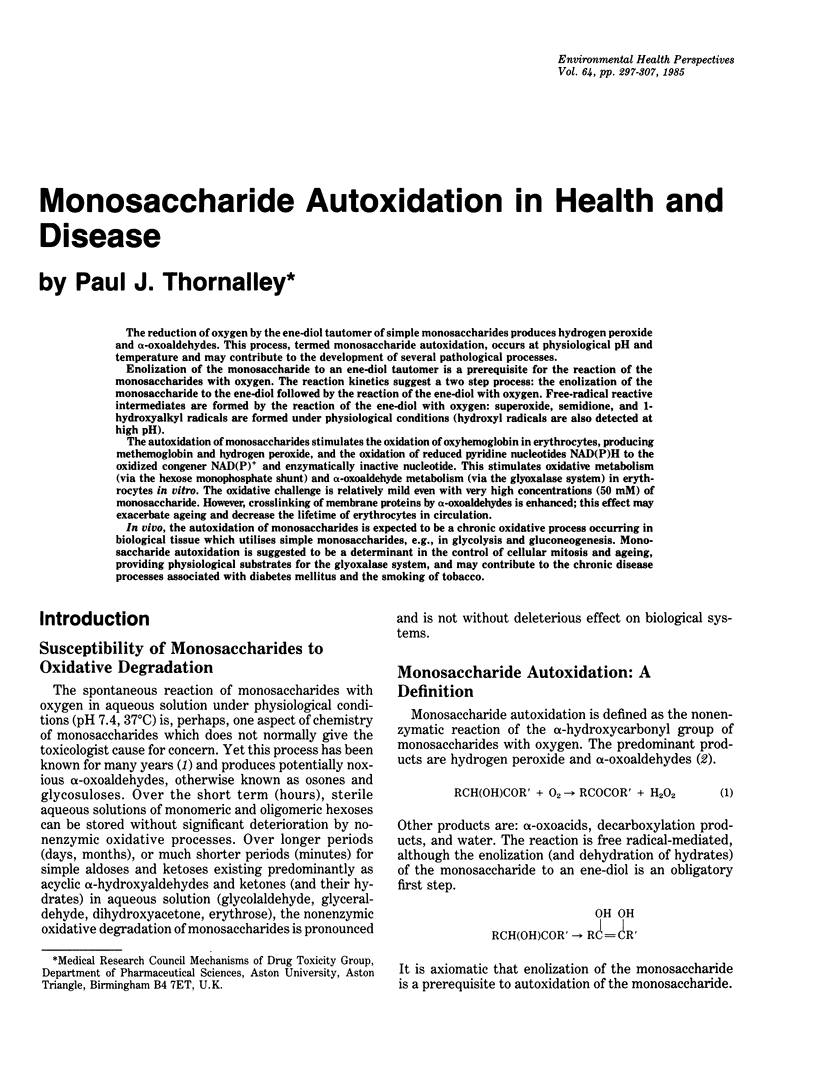
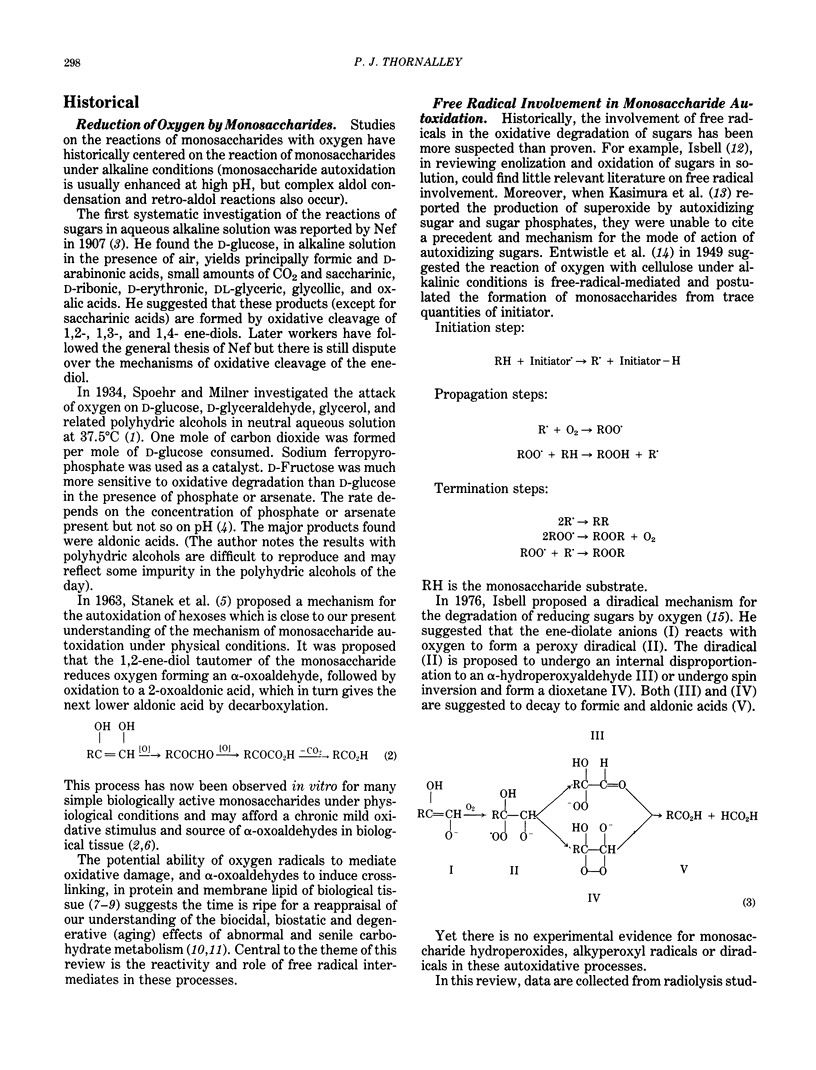
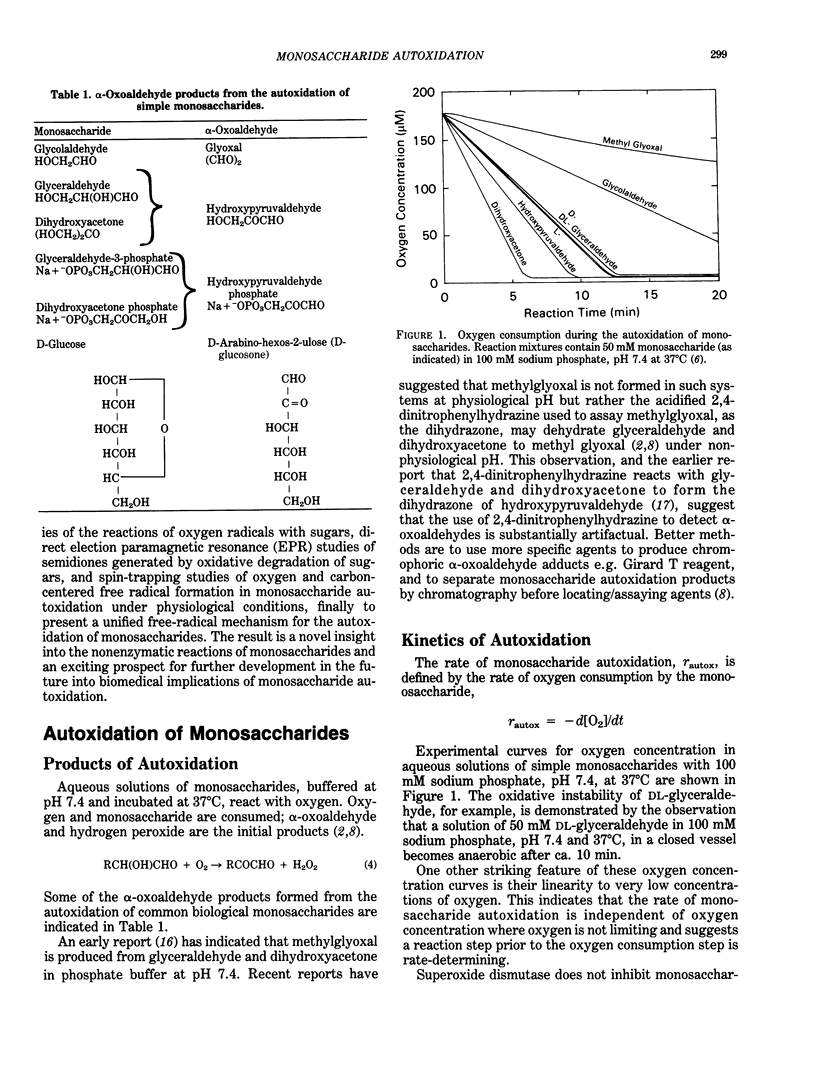
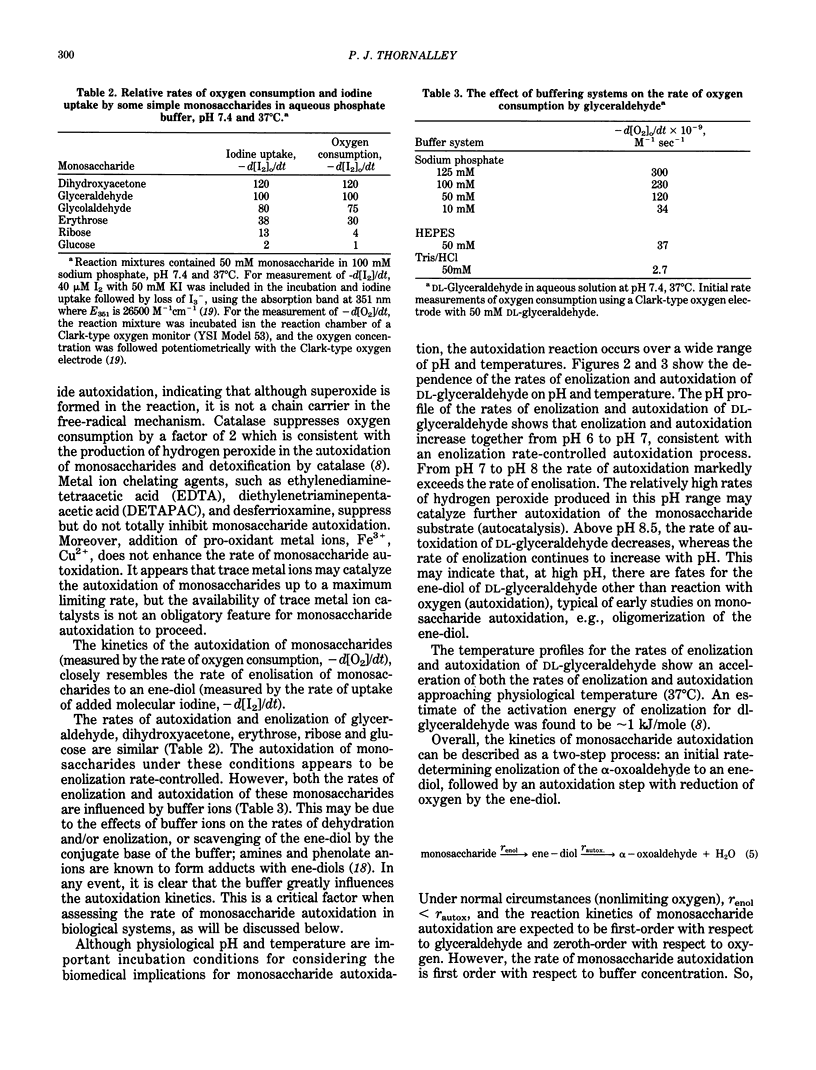
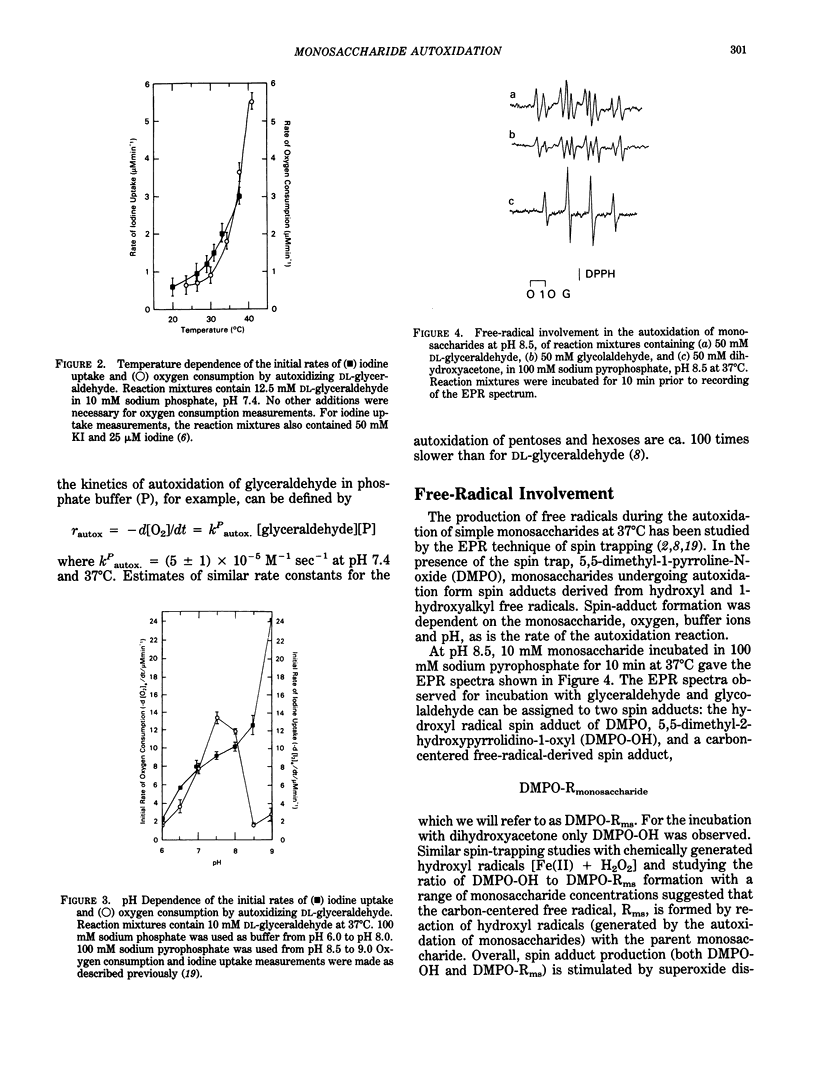
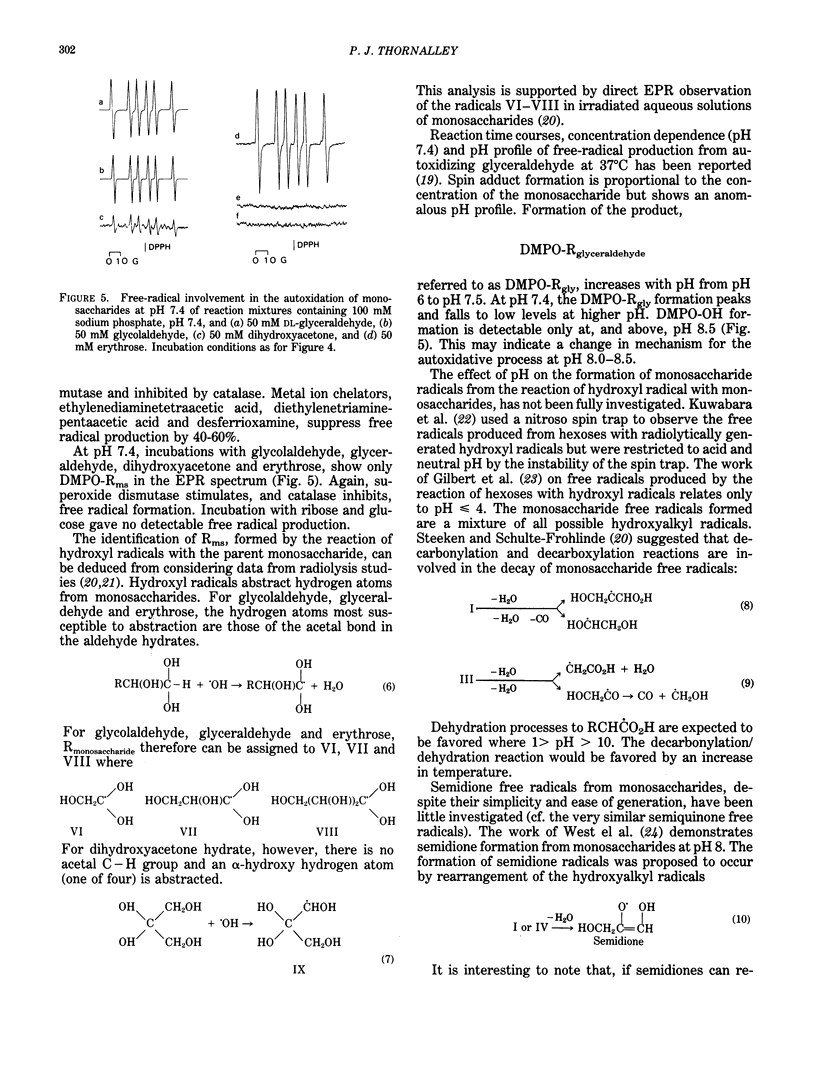
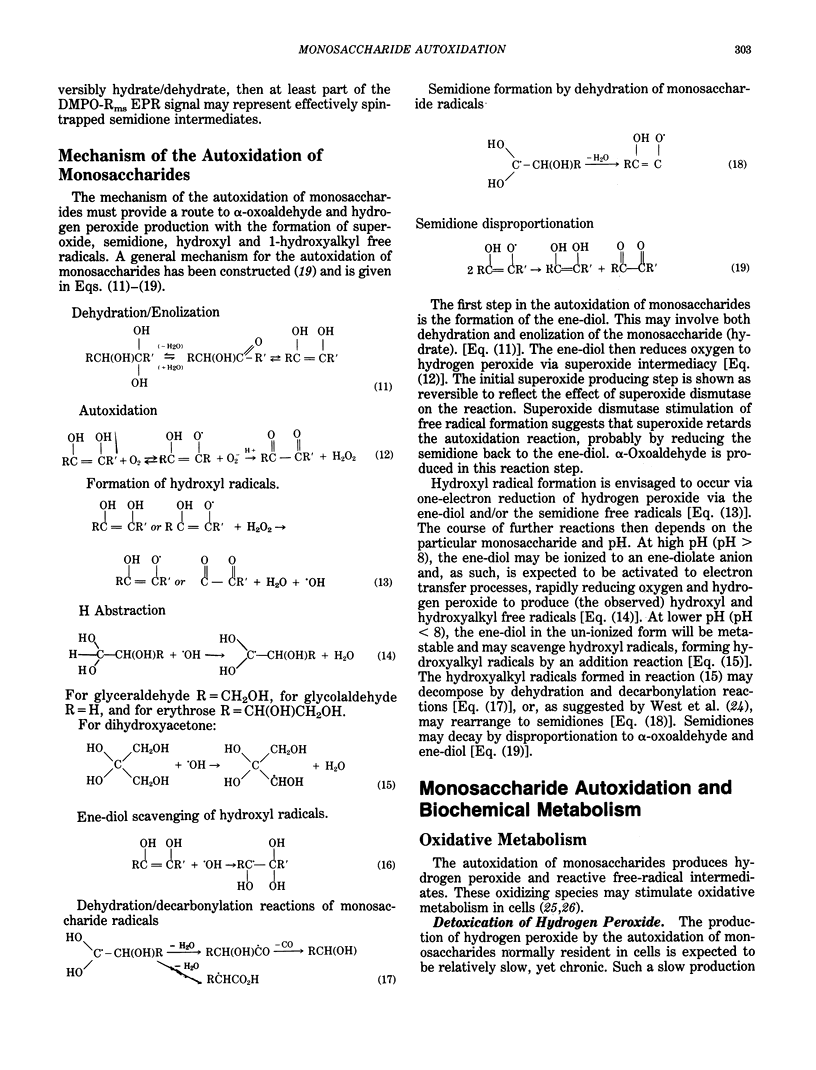
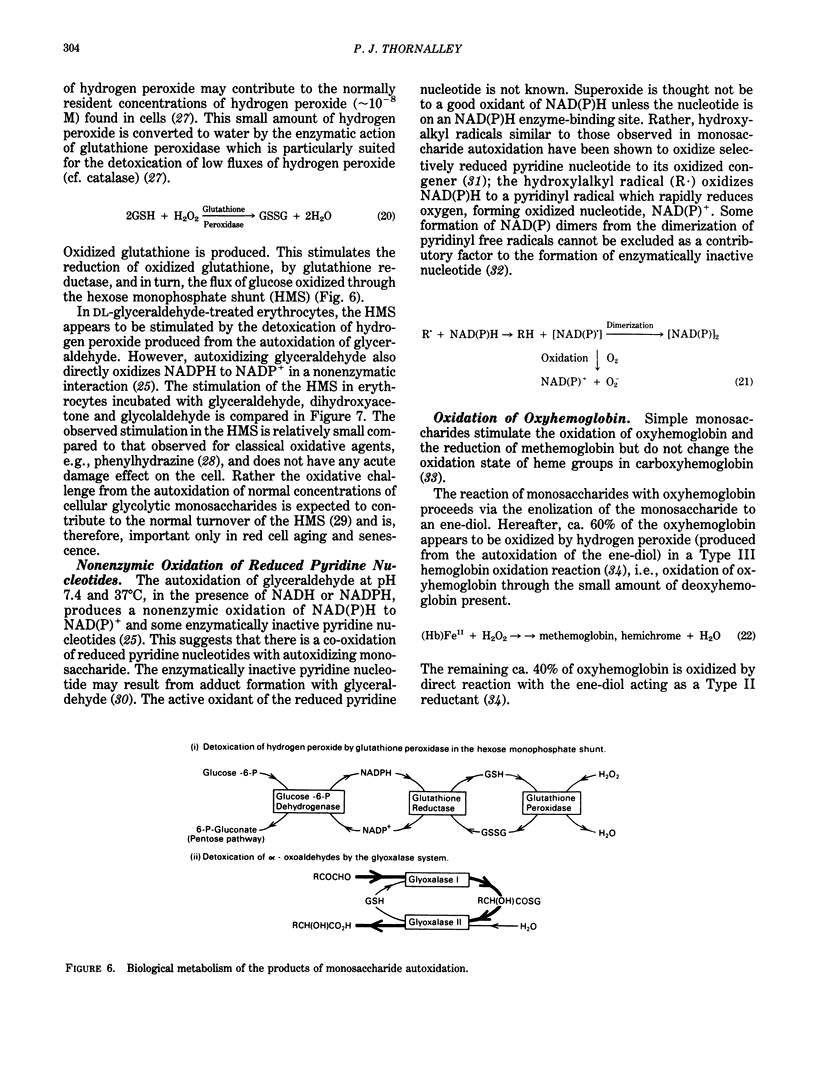
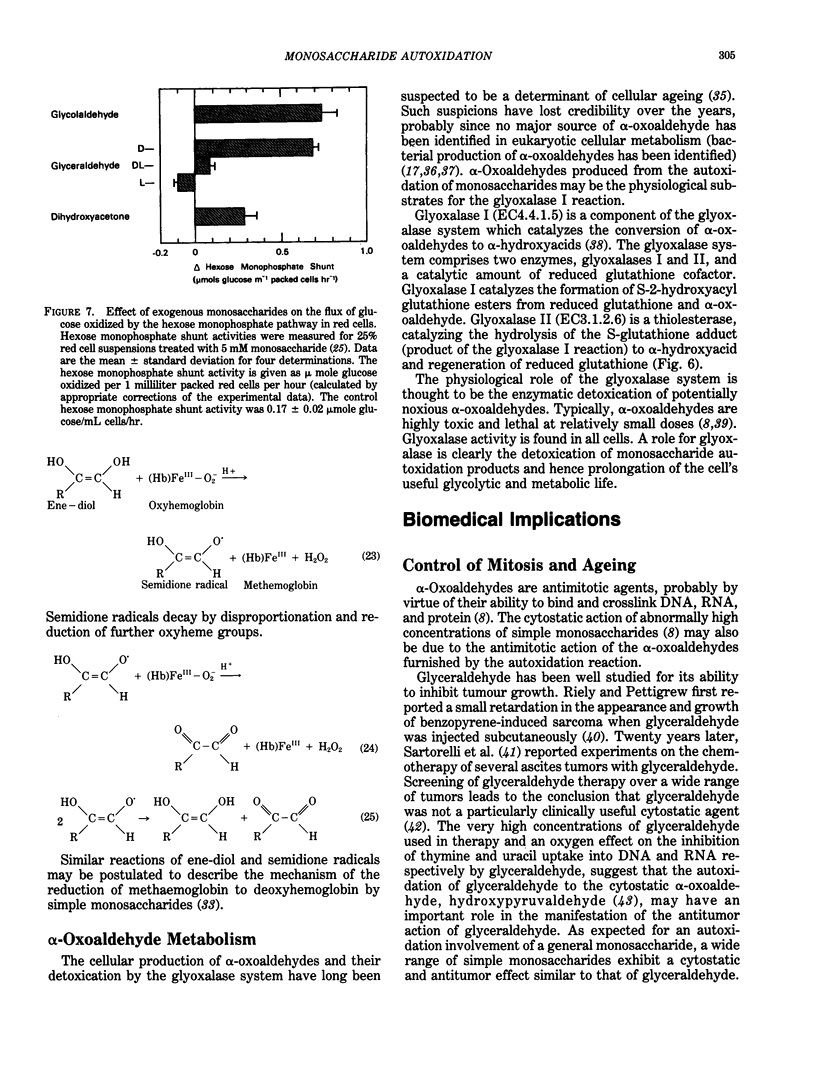
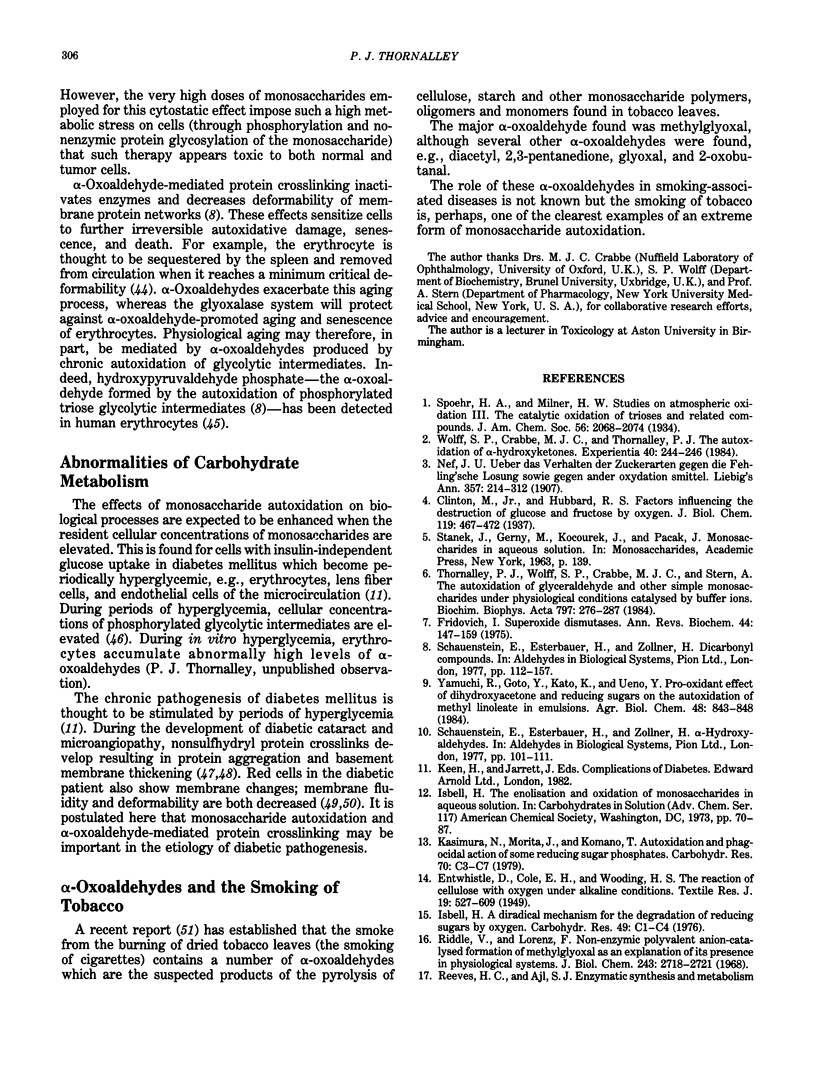
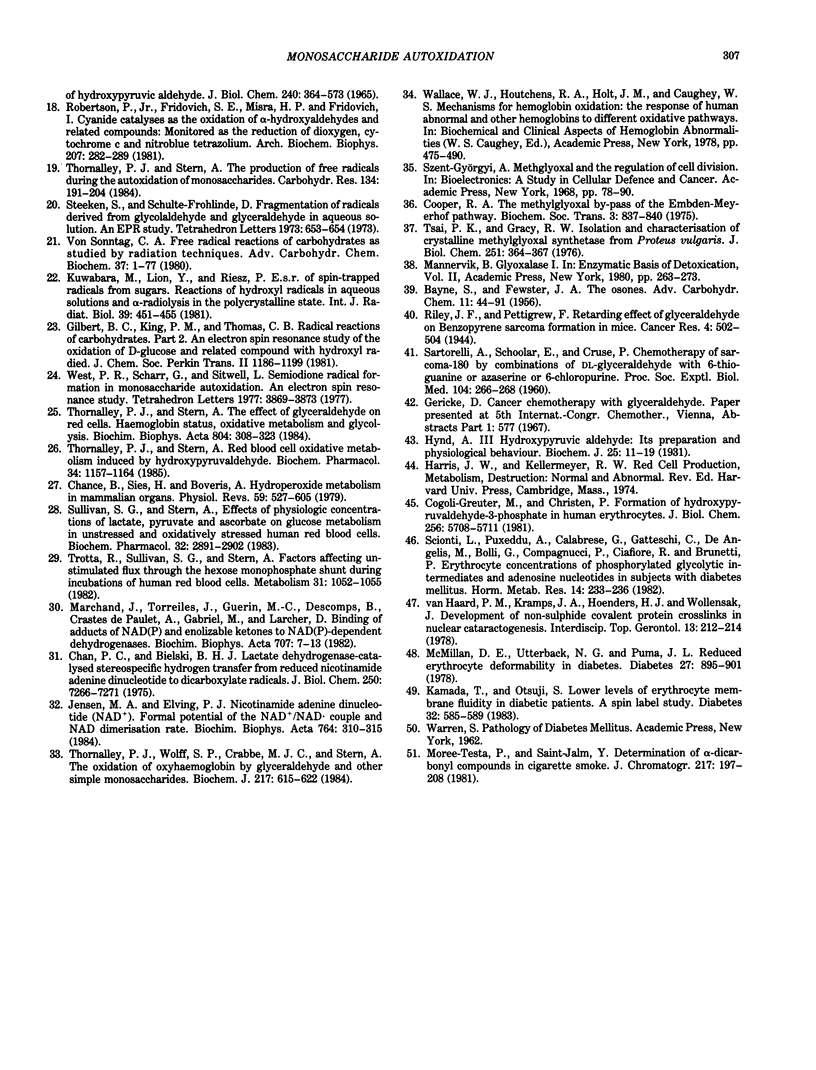
Selected References
These references are in PubMed. This may not be the complete list of references from this article.
- Chan P. C., Bielski B. H. Lactate dehydrogenase-catalyzed stereospecific hydrogen atom transfer from reduced nicotinamide adenine dinucleotide to dicarboxylate radicals. J Biol Chem. 1975 Sep 25;250(18):7266–7271. [PubMed] [Google Scholar]
- Chance B., Sies H., Boveris A. Hydroperoxide metabolism in mammalian organs. Physiol Rev. 1979 Jul;59(3):527–605. doi: 10.1152/physrev.1979.59.3.527. [DOI] [PubMed] [Google Scholar]
- Cogoli-Greuter M., Christen P. Formation of hydroxypyruvaldehyde phosphate in human erythrocytes. J Biol Chem. 1981 Jun 10;256(11):5708–5711. [PubMed] [Google Scholar]
- Fridovich I. Superoxide dismutases. Annu Rev Biochem. 1975;44:147–159. doi: 10.1146/annurev.bi.44.070175.001051. [DOI] [PubMed] [Google Scholar]
- Hynd A. Hydroxypyruvic aldehyde: its preparation and physiological behaviour. Biochem J. 1931;25(1):11–19. doi: 10.1042/bj0250011. [DOI] [PMC free article] [PubMed] [Google Scholar]
- Jensen M. A., Elving P. J. Nicotinamide adenine dinucleotide (NAD+). Formal potential of the NA+/NAD couple and NAD dimerization rate. Biochim Biophys Acta. 1984 Mar 30;764(3):310–315. doi: 10.1016/0005-2728(84)90101-4. [DOI] [PubMed] [Google Scholar]
- Kamada T., Otsuji S. Lower levels of erythrocyte membrane fluidity in diabetic patients. A spin label study. Diabetes. 1983 Jul;32(7):585–591. doi: 10.2337/diab.32.7.585. [DOI] [PubMed] [Google Scholar]
- Kuwabara M., Lion Y., Riesz P. E.s.r. of spin-trapped radicals from sugars. Reactions of hydroxyl radicals in aqueous solutions and gamma-radiolysis in the polycrystalline state. Int J Radiat Biol Relat Stud Phys Chem Med. 1981 Apr;39(4):451–455. doi: 10.1080/09553008114550561. [DOI] [PubMed] [Google Scholar]
- Marchand J., Torreilles J., Guerin M. C., Descomps B., De Paulet A. C., Gabriel M., Larcher D. Binding of adducts of NAD(P) and enolizable ketones to NAD(P)-dependent dehydrogenases. Biochim Biophys Acta. 1982 Sep 22;707(1):7–13. doi: 10.1016/0167-4838(82)90389-2. [DOI] [PubMed] [Google Scholar]
- McMillan D. E., Utterback N. G., La Puma J. Reduced erythrocyte deformability in diabetes. Diabetes. 1978 Sep;27(9):895–901. doi: 10.2337/diab.27.9.895. [DOI] [PubMed] [Google Scholar]
- REEVES H. C., AJL S. J. ENZYMATIC SYNTHESIS AND METABOLISM OF HYDROXYPYRUVIC ALDEHYDE. J Biol Chem. 1965 Feb;240:569–573. [PubMed] [Google Scholar]
- Riddle V., Lorenz F. W. Nonenzymic, polyvalent anion-catalyzed formation of methylglyoxal as an explanation of its presence in physiological systems. J Biol Chem. 1968 May 25;243(10):2718–2724. [PubMed] [Google Scholar]
- Robertson P., Jr, Fridovich S. E., Misra H. P., Fridovich I. Cyanide catalyzes the oxidation of alpha-hydroxyaldehydes and related compounds: monitored as the reduction of dioxygen, cytochrome c, and nitroblue tetrazolium. Arch Biochem Biophys. 1981 Apr 1;207(2):282–289. doi: 10.1016/0003-9861(81)90035-7. [DOI] [PubMed] [Google Scholar]
- SARTORELLI A. C., SCHOOLAR E. J., Jr, KRUSE P. F., Jr Chemotherapy of sarcoma 180 by combinations of DL-glyceraldehyde with 6-thioguanine or with azaserine and 6-chloro-purine. Proc Soc Exp Biol Med. 1960 Jun;104:266–268. doi: 10.3181/00379727-104-25802. [DOI] [PubMed] [Google Scholar]
- Scionti L., Puxeddu A., Calabrese G., Gatteschi C., De Angelis M., Bolli G., Compagnucci P., Calafiore R., Brunetti P. Erythrocyte concentration of glycolytic phosphorylated intermediates and adenosine nucleotides in subjects with diabetes mellitus. Horm Metab Res. 1982 May;14(5):233–236. doi: 10.1055/s-2007-1018980. [DOI] [PubMed] [Google Scholar]
- Sullivan S. G., Stern A. Effects of physiologic concentrations of lactate, pyruvate and ascorbate on glucose metabolism in unstressed and oxidatively stressed human red blood cells. Biochem Pharmacol. 1983 Oct 1;32(19):2891–2902. doi: 10.1016/0006-2952(83)90393-3. [DOI] [PubMed] [Google Scholar]
- Thornalley P. J., Stern A. Red blood cell oxidative metabolism induced by hydroxypyruvaldehyde. Biochem Pharmacol. 1985 Apr 15;34(8):1157–1164. doi: 10.1016/0006-2952(85)90489-7. [DOI] [PubMed] [Google Scholar]
- Thornalley P. J., Stern A. The effect of glyceraldehyde on red cells. Haemoglobin status, oxidative metabolism and glycolysis. Biochim Biophys Acta. 1984 Jul 20;804(3):308–323. doi: 10.1016/0167-4889(84)90134-4. [DOI] [PubMed] [Google Scholar]
- Thornalley P. J., Stern A. The production of free radicals during the autoxidation of monosaccharides by buffer ions. Carbohydr Res. 1984 Dec 1;134(2):191–204. doi: 10.1016/0008-6215(84)85037-5. [DOI] [PubMed] [Google Scholar]
- Thornalley P. J., Wolff S. P., Crabbe M. J., Stern A. The oxidation of oxyhaemoglobin by glyceraldehyde and other simple monosaccharides. Biochem J. 1984 Feb 1;217(3):615–622. doi: 10.1042/bj2170615. [DOI] [PMC free article] [PubMed] [Google Scholar]
- Thornalley P., Wolff S., Crabbe J., Stern A. The autoxidation of glyceraldehyde and other simple monosaccharides under physiological conditions catalysed by buffer ions. Biochim Biophys Acta. 1984 Feb 14;797(2):276–287. doi: 10.1016/0304-4165(84)90131-4. [DOI] [PubMed] [Google Scholar]
- Trotta R. J., Sullivan S. G., Stern A. Factors affecting unstimulated flux through the hexose monophosphate shunt during incubations of human red blood cells. Metabolism. 1982 Oct;31(10):1052–1056. doi: 10.1016/0026-0495(82)90151-2. [DOI] [PubMed] [Google Scholar]
- Tsai P. K., Gracy R. W. Isolation and characterization of crystalline methylglyoxal synthetase from Proteus vulgaris. J Biol Chem. 1976 Jan 25;251(2):364–367. [PubMed] [Google Scholar]


